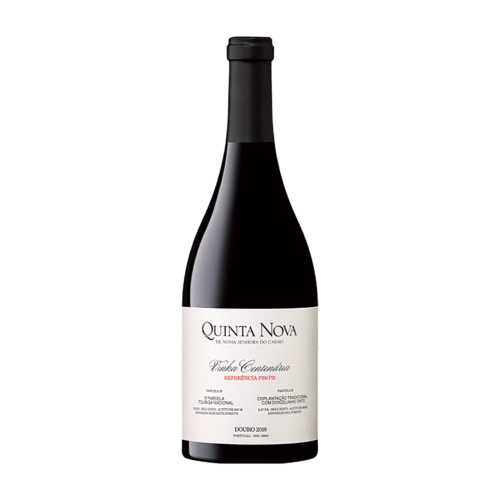Explore the freshest of the freshest. Check out our new collection of green wines. Click Here!
Explore the freshest of the freshest. Check out our new collection of green wines. Click Here!
Red Wine
Showing 1–9 of 108 resultsSorted by popularity
-

Maçanita Red Wine 2022 – Douro DOC
18,08 € Tax Included -

Quinta do Portal Reserva Red Wine 2021 – Douro DOC
20,34 € Tax Included -

La Rosa Reserva Red Wine 2021 – Douro DOC
39,55 € Tax Included -

Terra do Zambujeiro Red Wine 2018 – Alentejo DOC
32,77 € Tax Included -

Herdade das Servas Garrafeira 2015 Red Wine – Alentejo DOC
105,09 € Tax Included -

Religiosamente Guardado Red Wine 2013 – Alentejo DOC
253,12 € Tax Included -

Sobroso Red Wine 2023 – Alentejo DOC
11,30 € Tax Included -

Quinta Nova Vinha Centenária Ref P29/P21 2020 – Douro DOC
125,43 € Tax Included -

Marquês de Marialva Baga Reserva 2019 Red Wine – Bairrada DOC
12,43 € Tax Included
Portuguese red wine
Featured Portuguese grape varietals:
- Douro (Touriga Nacional): Known for its bold and structured profile, perfect for those who appreciate a powerful wine.
- Alentejo (Aragonez): Offers smooth textures and ripe fruit flavors, great for a versatile pairing option.
- Dão (Tinta Roriz): Delivers spice and cherry notes with elegant finesse, ideal for sophisticated palates.
- Lisboa (Castelão): Characterized by its rusticity and robust tannins, it pairs well with robust dishes.
Major red wine grape varieties
International Varieties:
- Cabernet Sauvignon: Known for its full body, high tannins, and flavors of dark fruits, often aged in oak.
- Merlot: Softer and fruitier than Cabernet Sauvignon, with flavors of plums and berries.
- Pinot Noir: Light-bodied with delicate flavors of red berries, and a signature earthiness.
Regional Specialties:
- Sangiovese: Italy’s key grape, known for its bright acidity and cherry flavors, often found in Chianti.
- Tempranillo: Spain’s star grape, offering flavors of red fruits, leather, and spice.
- Nebbiolo: A high-tannin, high-acid grape from Italy, known for producing Barolo and Barbaresco.
Red wine types (styles)
Light-Bodied Reds: These wines are lighter in color and tannins, with bright acidity and fruity flavors. Examples include Pinot Noir and Gamay.
Medium-Bodied Reds: These wines have more body and complexity, with balanced tannins and a mix of fruit and savory flavors. Examples include Merlot and Sangiovese.
Full-Bodied Reds: These wines are rich, intense, and often high in tannins, with deep, concentrated flavors. Examples include Cabernet Sauvignon and Syrah.
Famous red wine regions
- Bordeaux (France): Famous for its blends of Cabernet Sauvignon, Merlot, and other varietals.
- Burgundy (France): Known for its exceptional Pinot Noir wines.
- Tuscany (Italy): Renowned for Sangiovese-based wines like Chianti and Brunello di Montalcino.
- Alentejo (Portugal)
- Napa Valley (USA): Celebrated for its powerful Cabernet Sauvignons.
- Barossa Valley (Australia): Known for rich and bold Shiraz.
- Mendoza (Argentina): Famous for its robust Malbecs.
Red wines flavor profile
Red wines can exhibit a range of flavors, including berries, cherries, plums, spices, herbs, and earthy notes. Terroir and winemaking techniques significantly influence these flavors.
Red wines serving temperatures
- Light-Bodied Reds: Serve slightly chilled at 55-60°F (13-16°C).
- Full-Bodied Reds: Serve at room temperature, around 60-65°F (16-18°C).
Red wines food pairing
Classic Pairings:
- Cabernet Sauvignon: Pair with grilled meats and hearty stews.
- Pinot Noir: Perfect with roast chicken, duck, and mushroom dishes.
- Merlot: Complements pasta dishes, red meats, and roasted vegetables.
Pairing Principles for Different Red Wine Styles: Match the weight and intensity of the wine with the dish. Tannic wines pair well with fatty foods, while acidic wines balance richer dishes.
Red wines ageing potential
Not all red wines are meant to be aged, but those that are typically see a remarkable evolution in complexity and depth. Wines that are suitable for aging often have high tannin content, good acidity, and a robust flavor profile that can develop over time. Here are some examples of red wines that generally improve with age:
- Cabernet Sauvignon: Known for its high tannin and acid levels, Cabernet Sauvignon can age gracefully for 10-20 years, and sometimes longer. With age, it develops complex flavors of cedar, cigar box, and dried fruits.
- Bordeaux: High-quality Bordeaux blends, particularly those from the Left Bank, can age for decades, evolving from bold, tannic wines to smooth, nuanced expressions with notes of leather, truffle, and spice.
- Barolo and Barbaresco: Made from the Nebbiolo grape, these Italian wines are highly tannic and acidic, making them excellent candidates for long-term aging. They can develop flavors of roses, tar, and earth over 15-30 years.
- Rioja: Especially the Gran Reserva category, Rioja wines made from Tempranillo can age beautifully, developing complex flavors of tobacco, leather, and dried berries over 10-20 years.
- Syrah/Shiraz: Particularly from regions like the Rhône Valley and Australia’s Barossa Valley, Syrah/Shiraz can age for 10-15 years, gaining notes of smoke, meat, and spice.
- Amarone: This Italian wine made from dried grapes has a high alcohol content and intense flavors that can evolve over 10-20 years, showcasing dried fruits, chocolate, and tobacco notes.
How to store red wines
Store red wines in a cool, dark place with a constant temperature, ideally between 55-60°F (13-16°C).
How to choose a red wine
Consider your taste preferences, such as light and fruity or bold and tannic, when selecting a red wine.
Consider your taste preferences, such as light and fruity or bold and tannic, when selecting a red wine.
Red wine blends
- Bordeaux Blend: Typically includes Cabernet Sauvignon, Merlot, and other Bordeaux varietals.
- GSM: A blend of Grenache, Syrah, and Mourvèdre, popular in the Rhône Valley and Australia.